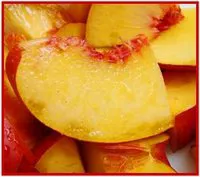 Nectarines are very accepted by consumers for their functional and quality properties. In addition, fresh-cut nectarine is one of the most appreciated fresh-cut product.
Nectarines are very accepted by consumers for their functional and quality properties. In addition, fresh-cut nectarine is one of the most appreciated fresh-cut product.Spanish scientists have evaluated the suitability of 4 nectarine cultivars to fresh-cut industry. For the study, ‘Early Top’, ‘Nectaprima’, ‘Big Top’, ‘Venus’ cultivar were compared because they are commonly grown in Spain.
Fruits were washed, peeled, cut in pieces and stored at 4°C in modified atmosphere packaging for 9 days. The samples were analysed at 0, 3, 6, and 9 days of storage.
Scientists measured total soluble solids (TSS), titratable acidity (TA), acceptability index (AI=TSS/TA), pH, color, firmness, head space gas composition, browning potential (BP), total phenolic content (TPC), and polyphenol oxidase activity (PPO).
Cultivars differed for titratable acidity: at the beginning of the storage, the AI was low for Venus’ and ‘Early Top’ (13.40 and 10.50, respectively), while it was higher for ‘Big Top’ and ‘Nectaprima’ (33.90 and 27.39, respectively).
‘Early Top’ and ‘Nectaprina’ showed a lower browning potential than ‘Venus’, in which the value was 4 times as high as the former. This result is also explained by PPO activity, which was lower in ‘Early Top’ and ‘Nectaprima’ pieces than in ‘Venus’ and ‘Big Top’ pieces.
Moreover, the scientists have studied the correlations between the measured variables to define better the suitability of nectarine cultivars to fresh-cut industry. They found that PPO activity was directly correlated with TPC and BP; while TPC is negatively correlated with TA and positively correlated with SST.
According to the correlation results, the scientists conclude that TSS, BP, TPC and PPO activity are useful parameters for fresh-cut nectarines characterization.
From comparison among cultivars, the scientists conclude that ‘Venus’ is the least suitable for fresh-cut processing because of its high BP and PPO activity; while ‘Early Top’ and ‘Nectaprima’ are resulted suitable for fresh-cut industry.
Source: Nogales-Delgado S., Del Carmen Fuentes-Pérez M., Ayuso-Yuste C., Bohoyo-Gil D., 'Study of different nectarine cultivars and their suitability for fresh-cut processing', 2013, International Journal of Food Science and Technology. Further info: http://onlinelibrary.wiley.com/doi/10.1111/ijfs.12282/abstract
